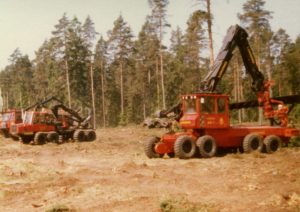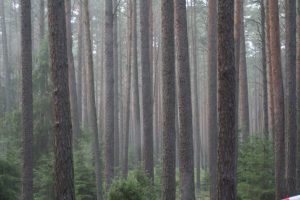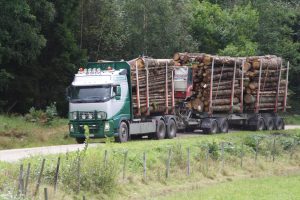Swedish forestry of today is more or less totally mechanized. The chainsaw is mainly used by private forest owners and to some extent by harvester teams to fell single oversized trees. However, when it comes to reforestation and pre commercial thinning the situation is slightly different.
As mentioned in the previous article (Swedish Forestry # 1) about Swedish forestry the tree harvesting machines came to stay already in the 1970´s. After that the chainsaw has become more and more unusual in the large scale, professional forestry.
Area regeneration
Still today the strategy in forest management is the same as it has been since the 1950´s – area regeneration. That means using clear cutting, planting, pre commercial thinning (one or two times), commercial thinning (one or two times) and then clear cut again after 60 – 80 years in the south of Sweden and 80 – 140 years in the north.
The species that are used in Sweden are more or less the same two in the whole country; Norwegian Spruce (Picea Abies) and Scots Pine (Pinus Silvestris). In some areas in mid Sweden, Logde Pole Pine (Pinus Contorta) is grown. In the south there are small areas with mainly hardwoods like Beech (Fagus Sylvatica) and Oak (Quercus Robur). Also Birch (Betula Pendula) is quite common in the whole country, but most in mixed stands together with Spruce and/or Pine.
The clear cutting has always been discussed in Sweden. The public don´t like it because it doesn´t look good, their mushroom- and berry picking areas are destroyed for some decades and it makes it more difficult to walk around in the forest. The environmentalists struggle for biodiversity and point out that the area regeneration favors only a few species and threatens most of the others. Therefor a discussion about continuous forest management has been going on for some years where Germany is pointed out as a role model. In Germany clear cuts are forbidden if they are over 0,5 hectares (approx. 1,2 acres). So far, the discussion has always landed in that the area regeneration is the most efficient method to use, even though some claim it´s not, and business goes on as usual.
It´s worth mentioning that disturbances like storm, wildfire, and damage by insects are a part of the boreal forests natural dynamics and many of the species in those forests are adapted to that. Area regeneration is quite similar to this kind of disturbances, especially if you save the areas and trees that would have survived storms, wildfires or insect attacks.
Right of public access
Also in private forests everybody in entitled to walk to pick flowers, mushrooms and berries. It´s called “Allemansrätt” The right of public access. However, it´s not allowed to take living trees or branches from them, or to drive any type of vehicle into the forest. You can camp for one night without permission from the landowner, if it is out of sight from any houses, and you can make a fire for food preparation, if there are no restrictions from the authorities.
Machine systems
Clear cut and commercial thinning
One thing that is very specific for forestry in Sweden, Norway and Finland is that we as good as only use the cut-to-length method, CTL. Full tree handling is only used when we talk about power line poles or similar. The trees are cut into lengths by harvesters in the forest and brought to the saw- and pulp mills on trucks.
The common machine system is one harvester and one forwarder. The size of the machines is depending on what type of cutting it is. Large machines for clear cuts and smaller machines for thinning. There are also mid-sized machines available that could be used for both thinning and clear cut.
Reforestation
88 % of the clear cuts are ground prepared with some kind of scarifyer before it´s either planted or left for natural regeneration. There are mainly two kinds of scarifyers available, trenchers and mounders. There are a modest number of planting machines in Sweden and Finland, but they represent (in Sweden) less than 1 % of the reforestation. Those planting machines give a very good quality but the planting with them is expensive.
Pre commercial thinning
Clearing, or pre commercial thinning (PCT) is mainly made by hand in Sweden, with cleaning saw. In some cases, machines are used if it´s possible to take the material for biomass – to chip it on the roadside. However, this is mainly done to clean roadsides, field sides and in some cases railroad sides.
Upcoming articles
This was a very brief presentation of Swedish forestry. In the upcoming articles we will go deeper into methods and technologies.
Sources: skogssverige.se
Photos: Per Jonsson















Good article Per, interesting to read about a different forestry perspective.
Thank you Muz. # 3 is underway and will be seen by the end of next week.